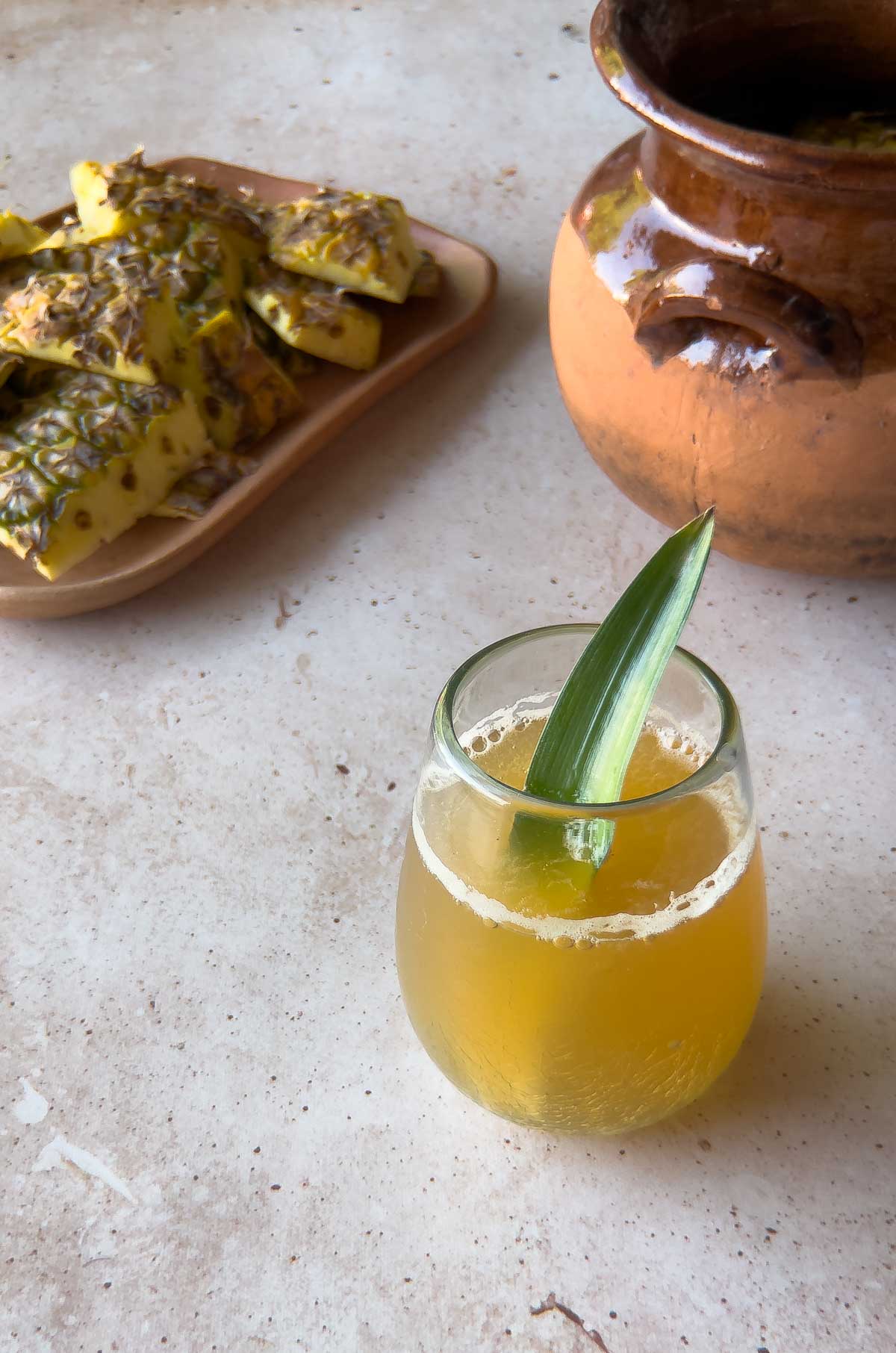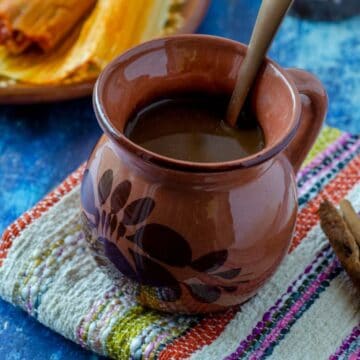A great introduction to making fermented drinks, this recipe for pineapple tepache (tepache de piña) is super simple, tasty, and refreshing; a perfect way to help cool down during these warm summer days!

Why this Recipe Works
Tepache is a beautiful example of fermentation, the natural wild yeast, and bacteria that live on the rind of the pineapple (and pretty much everywhere around us) will feed off the sugars found in the pineapple and the piloncillo, resulting in a fruity, aromatic, slightly sweet, and cider-like beverage.
A History
There are different theories about where the word tepache comes from; one of them being that the word originates from the Náhuatl tepatli meaning corn drink which itself may have been influenced by the word tepachoa meaning to be pressed or crushed by a rock—in short, a crushed corn drink. Before the conquest, the main ingredient was originally corn, but over time, it changed to being prepared with various fruits. That being said, pineapple is the one that this drink is more commonly associated with. In the state of Oaxaca, the original corn-based tepache is more readily available.

Tepache Benefits
Fermented foods and beverages, like tepache, aid in digestive health, providing our bodies with probiotics or “good” bacteria for your gut. Tepache is also high in vitamin C, and provides vitamins A, B, and magnesium.
I find that most people usually become hesitant when they hear anything that has to do with fermentation because it so often conjures up thoughts of strong scents and tastes or food “going bad”.
It’s easy to forget that fermentation in food is a natural process that has been done since (practically) the beginning of civilization across all cultures.
It’s all around us: in the beers at the family carne asada, the vinegar in your salad dressings, the cacao beans used to make your favorite hot chocolate, the small bottle of soy sauce at the table of your local Chinese restaurant, in the fresh loaf of sourdough bread you had that one time in San Francisco, in the — well, you get the point.
Try not to let any preconceived notions or prejudices of different food preservation and preparation techniques scare you away from the wonderful world of fermentation!
Ingredients:

Pineapple: Since we are going to be using the rind of the pineapple, you really want to aim for buying organic; this will generally result in a better fermentation as the natural bacteria and wild yeast will have a smaller chance of being affected by any (synthetic) pesticides.
Piloncillo: The piloncillo can be replaced with dark brown sugar, turbinado sugar, or any natural sugar replacement such as agave syrup.
Water: Use purified/filtered water. Avoid using tap water because any type of chlorinated water could potentially affect the fermentation process. Any regular bottled water will work fine here.
Step by Step Instructions

- Cut off ends of the pineapple.
- Cut rind off the pineapple.
- Place rind in a sterilized jar.
- Add piloncillo cones to the jar.

5. Add cinnamon stick.
6. Add purified water.
7. Give this a good stir, cover loosely with a lid or cheesecloth, and let it sit at room temperature away from direct sunlight. Let this ferment anywhere from 2-4 days
8. There will be bubbles and a layer of foam that forms on top of the tepache; this is completely normal and is encouraged as this is a sign of proper fermentation.
Serving:
Serve over ice or you can also serve it as a cocktail by adding tequila to it.
Storing:
If storing, the tepache will continue to ferment even when in the refrigerator. You can store the drink in one of two ways: with the cap loosely fitted — this will result in little to no carbonation or with the cap tightly sealed resulting in more carbonation. If you choose to store it with the cap tightly sealed, the excess carbonation might cause a mess when you open it up, so it’s recommended that you open the bottle over a kitchen sink.

FAQ
Is tepache similar to kombucha
Tepache and kombucha are both probiotic drinks, which means they both offer benefits to your gut by boosting the naturally occurring good bacteria in it. Although they are similar, tepache contains less sugar since it is made from pineapple. Kombucha is made from tea, and more sugar and additives are added to make it taste fruity and sweet.
Is there alcohol in tepache?
Tepache has an alcohol content about 2% ABV, though it can be less if you let it ferment for a shorter time, or more if you let it ferment for a longer.
Why did my tepache get moldy?
If you see mold growing, discard the tepache and start again. Make sure it is mold though. Mold is dry, fuzzy, and always sits on the surface. It is normal for a layer of white film or bubbles to appear. If this happens simply remove it.

Pineapple Tepache
Equipment
- 3-4 L glass jar
Ingredients
- 1 Large ripe pineapple
- 1 Ceylon cinnamon stick (5- inch)
- 3-6 Small piloncillo cones* (total weight 4.5 oz or 1/2 a large cone)
- 2 L Purified water
- 3 - 4 whole cloves, 2-3 allspice berries or 1 star anise (optional)
Instructions
- A reminder before starting: Since we are dealing with bacteria and wild yeast(s), it is crucial that we keep everything as clean and as sterile as possible to avoid any cross-contamination with unwanted or bad bacteria. When it comes to fermentation, you always want to treat it as if you were preparing a bottle for a baby.
- Gently rinse the pineapple using a soft-bristled brush under running warm water.
- Twist off the pineapple top and discard. Cut off and reserve both ends of the pineapple, cut the pineapple crosswise, and then cut the rind into medium-sized squares. In this recipe we aren’t going to be using the actual fruit, so you can eat it or save it for something else. This is optional, but you can also remove and use the pineapple core.
- Place the pineapple ends, rind and optional core along with the rest of the ingredients into a large 3-4 liter glass jar and fill with the water.
- Give this a good stir, cover loosely with a lid or cheesecloth, and let it sit at room temperature away from direct sunlight. Let this ferment anywhere from 2-4 days depending on your taste; the longer it sits, the stronger the flavor. There will be bubbles and a layer of foam that forms on top of the tepache; this is completely normal and is encouraged as this is a sign of proper fermentation. Stir and taste every 12-24 hours. I usually let mine sit out for 4 days.
- Once the tepache has reached your desired taste level, strain into a large glass pitcher and serve immediately with ice. To store, pour into a glass bottle that has a bottle cap, refrigerate, and consume within 2 days.
Notes
- Traditionally, a clay pot covered with a clean cloth would be used to ferment the tepache, but glass is the next best thing. If you want to go the more traditional route, I recommend a medium-sized clay pot that has been sterilized (both inside and out) with about a 1/2 cup of vodka and left to air dry completely. Plastic jars can also be used, but steer clear of anything made from reactive metals like tin, copper, or aluminum as these can affect the taste and color of the tepache
- Since we are going to be using the rind of the pineapple, you really want to aim for buying organic; this will generally result in a better fermentation as the natural bacteria and wild yeast will have a smaller chance of being affected by any (synthetic) pesticides.
- The piloncillo can be replaced with dark brown sugar, turbinado sugar, or any natural sugar replacement such as agave syrup.
- Use purified/filtered water. Avoid using tap water because any type of chlorinated water could potentially affect the fermentation process. Any regular bottled water will work fine here
- The tepache will continue to ferment even when in the refrigerator. You can store the drink in one of two ways: with the cap loosely fitted — this will result in little to no carbonation or with the cap tightly sealed resulting in more carbonation. If you choose to store it with the cap tightly sealed, the excess carbonation might cause a mess when you open it up, so it’s recommended that you open the bottle over a kitchen sink.
Nutrition
Although dorastable.com attempts to provide accurate nutritional information, these figures should be considered estimates.








I love making this Tepache. You use a part of the pineapple that you would otherwise discard, and get a delicious fermented pineapple drink.
This last time I made it, the liquid came out a little slimy after 4 days of letting it sit and ferment. Any ideas what went wrong?
This is a sign that the wrong kind of bacteria has taken hold of your tepache.